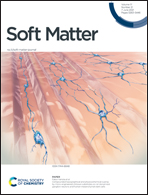Physics-informed constitutive modelling of hydrated biopolymer aerogel networks
Abstract
Hydration induces significant structural rearrangements in biopolymer aerogels, resulting in a completely different mechanical behaviour compared to the one in the dry state. A network decomposition concept was earlier introduced to account for these changes, wherein the material network was decomposed into an open-porous aerogel one and a hydrogel-like one. Recent experimental evidences have supported this idea of the formation of a hydrogel-like network. Using these observations as a basis, in this paper, we present a micromechanical model describing the effect of hydration on the structural and mechanical properties of aerogels. The aerogel network is modelled based on the mechanics of their pore-walls, while the hydrogel-like network is modelled based on the statistical mechanics of their polymer chains by means of the Arruda–Boyce eight-chain model. The influence of diverse structural and material parameters on the mechanical behaviour is investigated. The effect of different degrees of wetting, from a pure aerogel to a pure hydrogel-like state, is captured by the model. The results are shown to be in good agreement with available experimental data.



 Please wait while we load your content...
Please wait while we load your content...